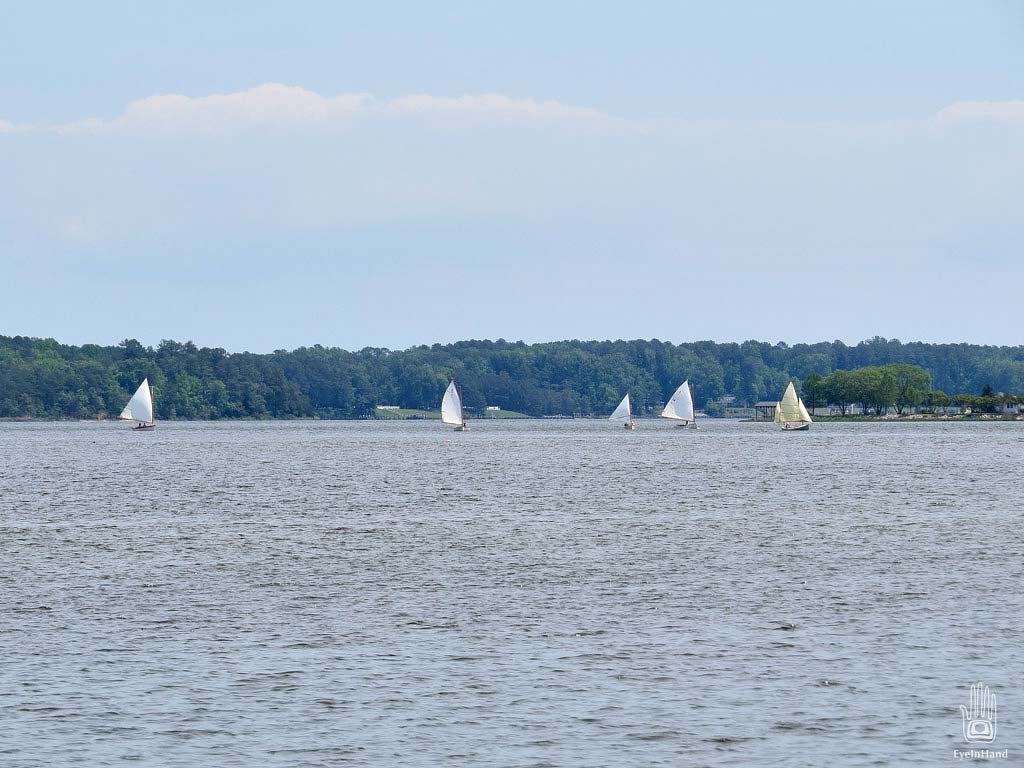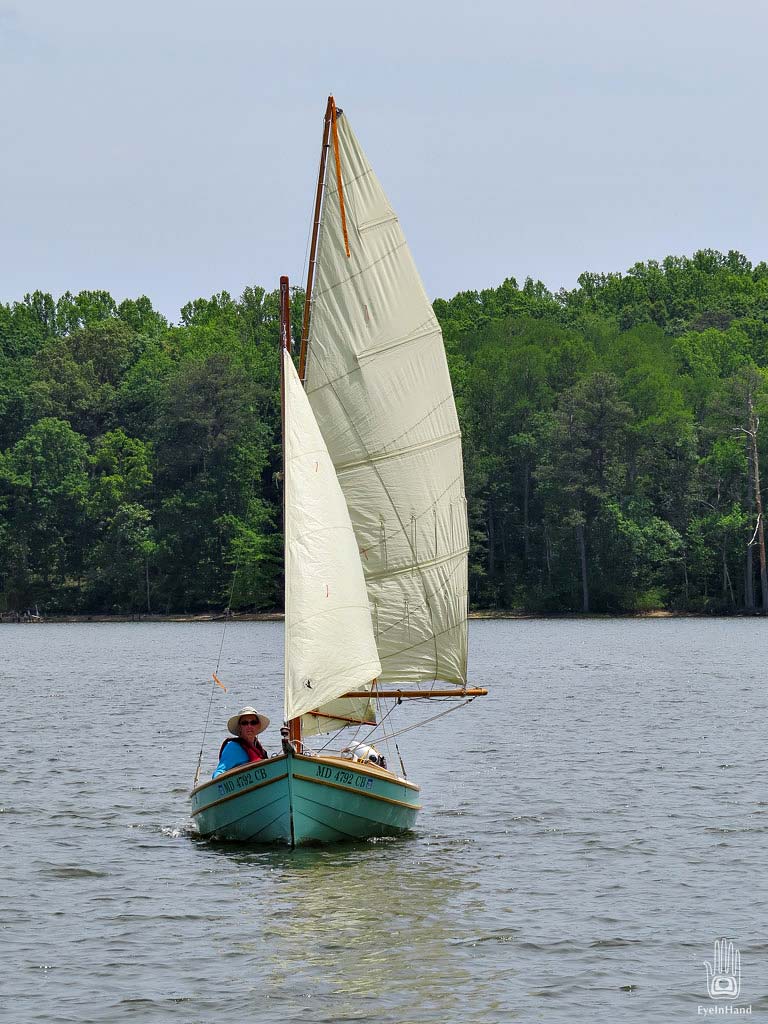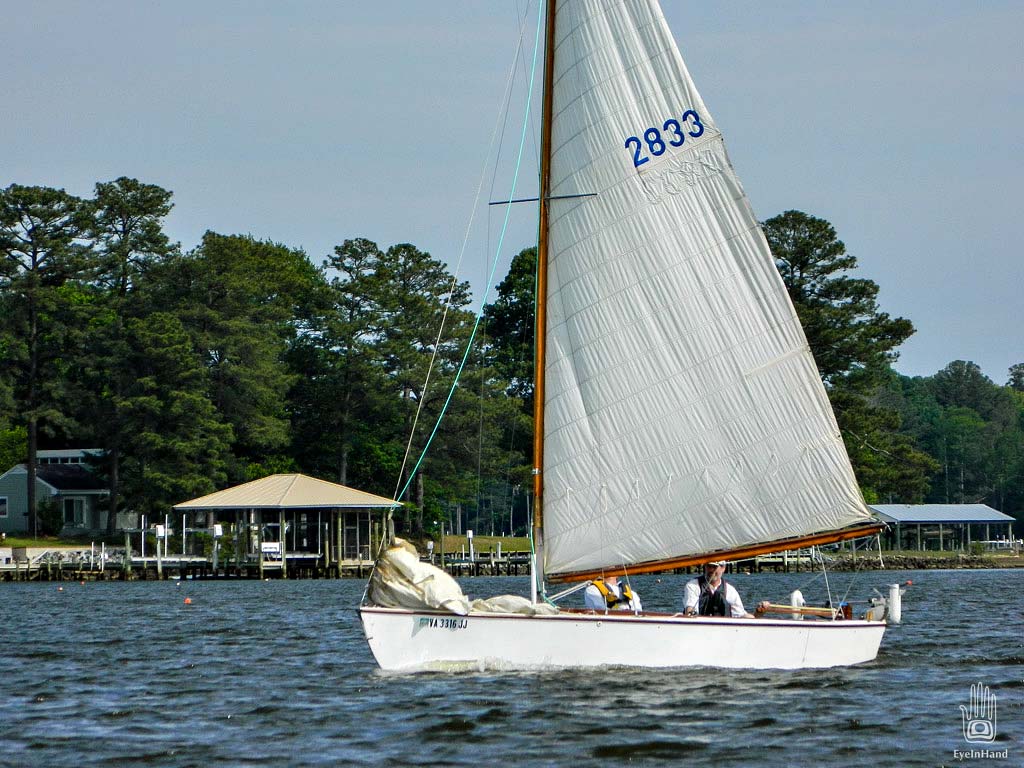Still more to do on the Lightning before she could sail. Raising sails for only the second time, for instance, it became clear the halyards were going to be a problem. While attending to that I broke a few more things, so had to fix those, too.
Like other older racing boats, Lightnings have two-part halyards. The half you haul away on is conventional line, fat and comfortable in the hand. The other half is thin wire. The idea is when fully raised and cleated off it’s mostly the wire under tension, which doesn’t stretch much. Makes sense: Set it once and it’s good for the day.
But instead of a nice clean splice where the two halves meet, this boat had an eyelet in the wire through which passed the line, finished off with a whopper of a stopper knot about the size of a golf ball. Functional, but also the perfect size to wedge snuggly on the way down in the Vs formed by the Struts and Shrouds. With crew to pay attention to such things it might not be such a big deal. Let them fuss with it when raising and lowering sail while you tend the tiller. But sailing single-handed, this would be a severe handicap. When you’re alone, and need to lower the jib, you generally want it to come down smooth and fast. This would not do.
I lowered the mast again and replaced the whole thing with a single length of low stretch Dyneema. Which luckily I had packed among the supplies. In the process of doing that I bent the bronze gooseneck on the boom. Because, stupid me, I wanted to see if you could lower the mast without taking everything apart – as you might want to do on the water to get under a low bridge. Had to pull out the hammer and spent a good half hour straightening out that and the sail track, which also bent.
And so on.
Around 11 o’clock, Kevin B sent a text saying they were heading back. I figured by the time the Lightning was re-rigged the boats would be rounding the bend and coming in for lunch, so I finished up, grabbed the camera, and went to the dock to watch for them.
It’s pretty cool seeing a bunch of boats sail into harbor together. It’s something you don’t see often anymore. One minute the scene looks normal, maybe see tips of sails over the trees. Then the whole horizon is speckled with white sails doing slow pirouettes on the water, growing larger and getting closer imperceptibly, the way clouds do.
As they came near, I noticed Pete’s Marsh Cat Obadiah sporting a new nosegay. A luridly painted mermaid fender. He did victory laps in front of the dock, like she was some sort of trophy. The wind was picking up. He and Kevin and Doug, reluctant to stop, sailed back and forth until hunger brought them in.
The forecast had kept some of the usual Float guys at home. And though rain was coming for sure, these first two days were glorious – warm, sunny, with just enough wind to keep it interesting. Everyone looked happy.
Once ashore, they all wanted to know if and when the Lightning was going to sail. Pete and Eddie in particular were giving me a hard time, and threatened to have the other guys hold me while they launched and sailed it. I explained about the fixing. Then they repeated the question. I reminded them it was supposed to start raining tonight and not stop. In fact, a couple of guys had already hauled out and headed for home, before the weekend even started. They repeated the question.
Pete finally convinced me, said people were on hand to help and he would even come with me. Alright, fine, says I. No better time to have something else break, on the water, than when you’ve got a crowd watching who can fish you out.
A bunch of guys lined the dock to hold lines and give direction. There was a small cheer when the boat floated off the trailer.
I handed the bow line to Pete and started to park the trailer. I think at that point reality began to sink in. He said, “So this boat hasn’t been sailed in how long?”
“At least five years. Maybe six. And I’ve never sailed her. Or even one like her.”
He looked at the boat for a moment. I could see him mentally tabulating the known facts. The wind was piping up, blowing straight up the river. Sails were popping and flapping on the other boats still in the water.
“How many life jackets do you have?”
“Just one. Didn’t figure I’d put anyone else at risk. You have one, right? Might want to bring it.”
He nodded, handed the line off to the nearest person on the dock and went to get it. When I got back he was already on the dock wearing it. Smart guy.
I said, “Well, are you coming? You talked me into this . . . ” We climbed aboard, fired up the trolling motor to get free of the lee dock, and we were away.
Water started seeping in around the centerboard immediately. Not fast, but steady. Once far enough from shore to give us working room, Pete raised the sail, I stowed the motor, and suddenly, quite suddenly, we were sailing.
More importantly, sailing under control. I had been told the boat is relatively sedate with only the main sail raised. The jib is less than half the size of the main, but provides 80% of the power. Hard to believe. When the boat actually behaved well – stable and sure footed, even sailing smartly – let’s just say it was a very pleasant surprise, and I think we both let out a little sigh of relief.
The first thing that became apparent is the old original sails are just too old and worn out to be much good. Tightening the vang down helps, but even then there’s so much bagginess in the cloth it flutters constantly. Dimples ripple the panels between all the seams. The cloth is supple and nice to handle, but that’s about it.
With the sail up creating a load against the centerboard, water was seeping in faster than on the first test float. Within a half hour it was up to the bottom of the floorboards. We sailed by the dock and out to where Kevin and Doug were noodling about. Steve W was on board with Kevin and took a couple of photos. (Thanks Steve!)
With the five foot centerboard feeling around the depths we ran aground once in shoal water, but raised the board a little and were off again.
Another relief was finding that the rudder works well. It will take more than one trip to confirm this, but it seems fine. For one thing, designed for racing the boat is well balanced. There’s almost no weather helm until the boat heels. That means there’s very little pressure on the rudder. When I let go the tiller it pretty much stays put. I may rake the mast a little to add a bit of weather helm, just enough so the boat will round up on its own.
For the last thirty minutes, we raised the jib to get a feel for what it feels like with the whole rig up. Even with sloppy sails I could feel her rear up and get ready to go. Definitely more heeling in the puffs, enough that I luffed maybe too quickly.
I’ll be anxious to try the newer sails. If the rains would just hold off another day I could try them. And by tomorrow would know if the seams will swell closed. But it is not to be, for this trip at least. Back at the dock I checked the radar and see a tide of heavy rain moving up from the South.
We all hauled out and battened things down for the night. 2833 was back on the trailer. I pumped out the bilge and started pitching the tent until Doug came to say the crabs were ready. And oysters.





















Success! The main does have an odd shape. Fine boat, very fine boat. Want to trade for a stone horse? 😉
Ha! I wish.
Tried the other main on Saturday. Worked very well. Success! Made 5 knots under main alone. On which more later.
Loved the photos of the Canadian invasion.